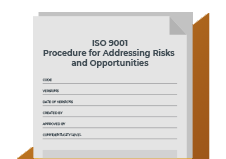Internal and external issues and risks and opportunities prioritization
Assign topic to the user
Answer:
Internal and external issues differ from organization to organization but there are some that are common for all organization. Internal issues can be the organizational structure, the culture of the organization, issues related to your employees (current competence vs needed competence, their needs and expectations, etc), issues related to technology and equipment your organization use, etc.
External issues are related to the external environment in which the company operates, this can be economical and political situation in your country, legislation, but also needs and expectations of external interested parties such as your supplier, subcontractors, customers, etc.
Determining internal and external issues is closely related to the identification of needs and expectations of interested parties and that can be e asier and can provide you with inputs on what to consider when addressing internal and external issues. There is no formal requirement to document context of the organization but it can be very useful to do so when you are doing it for the first time.
For more information, see:
- How to identify the context of the organization in ISO 9001:2015 https://advisera.com/9001academy/blog/2015/05/26/how-to-identify-the-context-of-the-organization-in-iso-90012015/
- How to determine interested parties and their requirements according to ISO 9001:2015 https://advisera.com/9001academy/blog/2015/11/10/how-to-determine-interested-parties-and-their-requirements-according-to-iso-90012015/
The crucial step in identifying risks and opportunities is to properly determine context of the organization. Once you have this information you can start thinking about the risks and opportunities regarding your QMS. There is no single way to prioritize risks and opportunities but you should start with risks and opportunities that are directly affecting quality of your products and services and customer satisfaction, or start with ones that require least resources and time and can be resolved easily. Important thing is to make plan to address risks and opportunities, meaning to define resources, responsibilities and actions to address each risk and opportunity.
For more information, see:
- Methodology for ISO 9001 Risk Analysis https://advisera.com/9001academy/blog/2015/09/01/methodology-for-iso-9001-risk-analysis/
- The Role of Risk Assessment in the QMS https://advisera.com/9001academy/blog/2014/01/07/role-risk-assessment-qms/
Comment as guest or Sign in
Jan 12, 2016


